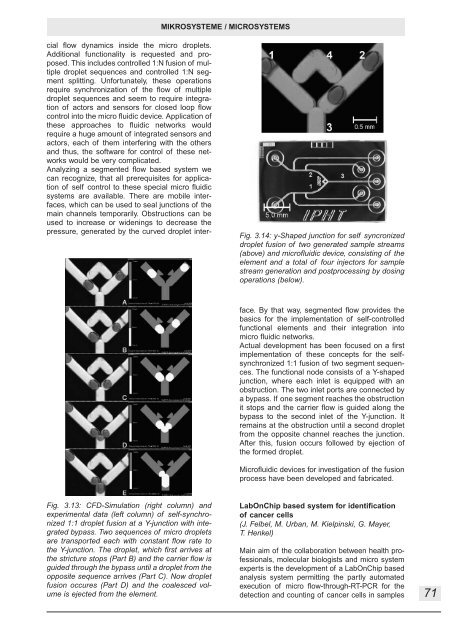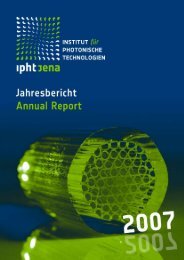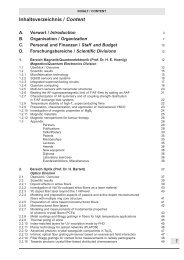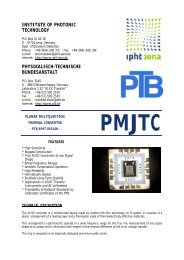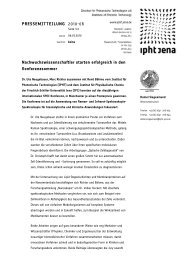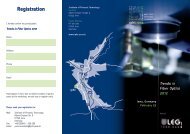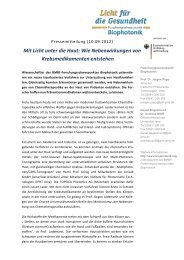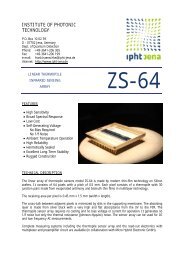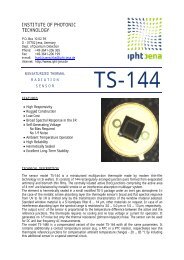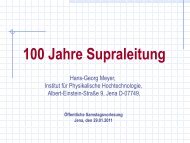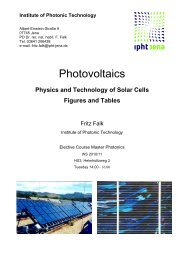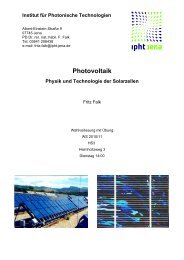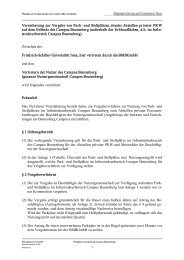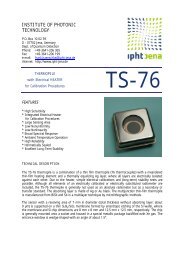Jahresbericht 2005 - IPHT Jena
Jahresbericht 2005 - IPHT Jena
Jahresbericht 2005 - IPHT Jena
Create successful ePaper yourself
Turn your PDF publications into a flip-book with our unique Google optimized e-Paper software.
cial flow dynamics inside the micro droplets.<br />
Additional functionality is requested and proposed.<br />
This includes controlled 1:N fusion of multiple<br />
droplet sequences and controlled 1:N segment<br />
splitting. Unfortunately, these operations<br />
require synchronization of the flow of multiple<br />
droplet sequences and seem to require integration<br />
of actors and sensors for closed loop flow<br />
control into the micro fluidic device. Application of<br />
these approaches to fluidic networks would<br />
require a huge amount of integrated sensors and<br />
actors, each of them interfering with the others<br />
and thus, the software for control of these networks<br />
would be very complicated.<br />
Analyzing a segmented flow based system we<br />
can recognize, that all prerequisites for application<br />
of self control to these special micro fluidic<br />
systems are available. There are mobile interfaces,<br />
which can be used to seal junctions of the<br />
main channels temporarily. Obstructions can be<br />
used to increase or widenings to decrease the<br />
pressure, generated by the curved droplet inter-<br />
Fig. 3.13: CFD-Simulation (right column) and<br />
experimental data (left column) of self-synchronized<br />
1:1 droplet fusion at a Y-junction with integrated<br />
bypass. Two sequences of micro droplets<br />
are transported each with constant flow rate to<br />
the Y-junction. The droplet, which first arrives at<br />
the stricture stops (Part B) and the carrier flow is<br />
guided through the bypass until a droplet from the<br />
opposite sequence arrives (Part C). Now droplet<br />
fusion occures (Part D) and the coalesced volume<br />
is ejected from the element.<br />
MIKROSYSTEME / MICROSYSTEMS<br />
Fig. 3.14: y-Shaped junction for self syncronized<br />
droplet fusion of two generated sample streams<br />
(above) and microfluidic device, consisting of the<br />
element and a total of four injectors for sample<br />
stream generation and postprocessing by dosing<br />
operations (below).<br />
face. By that way, segmented flow provides the<br />
basics for the implementation of self-controlled<br />
functional elements and their integration into<br />
micro fluidic networks.<br />
Actual development has been focused on a first<br />
implementation of these concepts for the selfsynchronized<br />
1:1 fusion of two segment sequences.<br />
The functional node consists of a Y-shaped<br />
junction, where each inlet is equipped with an<br />
obstruction. The two inlet ports are connected by<br />
a bypass. If one segment reaches the obstruction<br />
it stops and the carrier flow is guided along the<br />
bypass to the second inlet of the Y-junction. It<br />
remains at the obstruction until a second droplet<br />
from the opposite channel reaches the junction.<br />
After this, fusion occurs followed by ejection of<br />
the formed droplet.<br />
Microfluidic devices for investigation of the fusion<br />
process have been developed and fabricated.<br />
LabOnChip based system for identification<br />
of cancer cells<br />
(J. Felbel, M. Urban, M. Kielpinski, G. Mayer,<br />
T. Henkel)<br />
Main aim of the collaboration between health professionals,<br />
molecular biologists and micro system<br />
experts is the development of a LabOnChip based<br />
analysis system permitting the partly automated<br />
execution of micro flow-through-RT-PCR for the<br />
detection and counting of cancer cells in samples<br />
71


